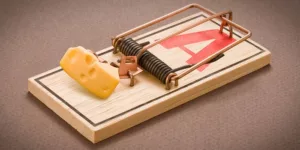Mouse traps are amazing devices to get rid of all the mice making a mess of your house. But there is a high chance that you may not be setting up the traps right reducing the effectiveness of it. Here we have compiled some mouse-trapping errors that people tend to make and more importantly solutions which you should be pursuing instead to maximize its effectiveness. Try these and get rid of all the mice as easily as possible.
Ruining the bait
Mice are good detectors. They can easily detect the scent on traps that you have handled inappropriately. This prevents the mice from getting trapped. To prevent this, wear gloves when managing mouse trap bait and setting mouse traps. Use gloves that are used for health care and washing dishes. Also use them to manage a trap after it has caught the mice to protect yourself from potential diseases.
Using the wrong food
There has been a conception ingrained in our minds after watching episodes of Tom & Jerry, that mice are attracted to cheese. Mice are primarily nut and seed eaters so you can use peanut butter instead to lure them. You can also try chocolate since they are tempted to more calories. Mice tends to come in when the temperature drops outside. You can also use materials like cotton balls and yarns to bait them since they look for warmth.
Using too much bait
Using too much bait is a common mistake that many mice trappers commit. It causes pests to steam some of it without getting caught in the mouse traps. Use the right amount of tiny bait but make sure it is adequate enough to attract mice.
Expecting instant results
Mice are naturally aware of the new objects in the area they frequently roam. You can bait them by insetting the mouse traps for a few days whether you are using classic or electronic mouse traps. Once you see the mouse getting trapped into baits, you know that they are in the right place. Just keep some patience and let the magic happen.
Setting traps in the wrong place
People commonly make this error. Mice are naturally scared of open areas so they trot around boundaries of the room, close to the walls. Place mouse traps along places where they primarily travel. Make sure the bait is facing the wall so mice will be enticed to explore them rather than just walk around them. If possible, place mouse traps in concealed areas.
Starting slow
There are surveys and studies conducted which reflects the fact that mice are more often caught on the first night you set the trap than on other subsequent night. You should start your activity by setting mice traps wherever you see sign of their presence. Use more traps and place them together to increase its effectiveness. Also try different types to make sure that you catch mice in your opening night only.








